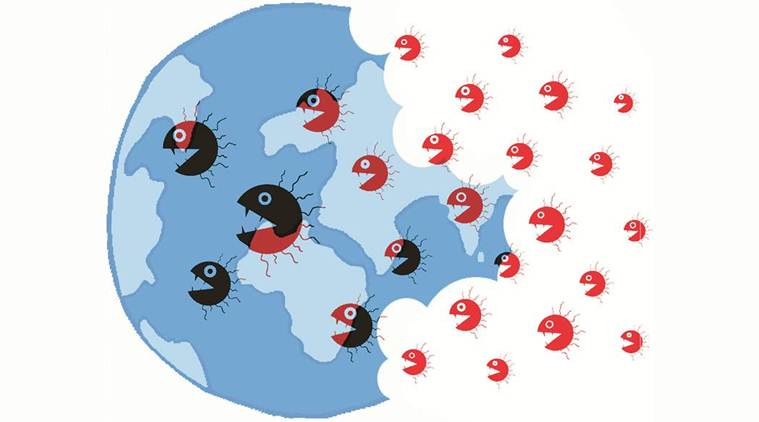- India
- International
Like SARS and MERS, India may escape Coronavirus, but we need to invest, build capacity and be ready
With multiple cities in China under a public health lockdown, global supply chains of various essential products and consumer goods are likely to be affected. This should be particularly worrisome for India, which has a roughly $93 billion total trade and about $57 billion trade imbalance with China.
 With the World Health Organisation declaring it a Public Health Emergency of International Concern (PHEIC), this outbreak is now a pandemic. (Illustration by C R Sasikumar)
With the World Health Organisation declaring it a Public Health Emergency of International Concern (PHEIC), this outbreak is now a pandemic. (Illustration by C R Sasikumar)
Public health experts have worried most about an animal virus that gets into humans, causes human-to-human transmission, has high infectivity and a range of clinical severity, with no human immunity, no diagnostic tests, drugs or vaccines. An emerging virus, called the 2019 novel coronavirus (2019-nCoV), appears to be just that. With the World Health Organisation declaring it a Public Health Emergency of International Concern (PHEIC), this outbreak is now a pandemic.
An outbreak that began in Wuhan, China, with the first confirmed case on December 12 has spread to 27 countries with a total of 64,436 cases and 1,383 deaths (as of February 14, 9:43 am IST). A majority of cases (63,854) and all but three deaths have so far been reported from mainland China, with the most cases (51,986) and deaths (1,318) in Hubei province. It has spread to all provinces of China and is quickly moving across the globe. On January 30, India’s Ministry of Health and Family Welfare confirmed the infection in a student from Wuhan University currently in Thrissur, Kerala. Since then, two other students from Wuhan have tested positive in Alappuzha and Kasaragod districts of Kerala, with over 3,200 under observation and 34 in isolation wards across the state. Indians stuck in Wuhan, who were airlifted back to country have all tested negative and are under quarantine for two weeks.
Coronaviruses are a group of animal viruses identified by their crown-like (corona) appearance under a microscope. The 2019-nCoV belongs to this group of viruses, six of which, including the 2003 Severe Acute Respiratory Syndrome (SARS) and the 2012 Middle East Respiratory Syndrome (MERS) viruses, were earlier known to cause disease in humans. Since the SARS outbreak in 2003, scientists have discovered a large number of SARS-related coronaviruses from their natural hosts — bats. Previous studies have shown some of these bat coronaviruses to have the potential to infect humans.
Opinion: A World Away in Wuhan
In a publication uploaded on bioRxiv, a preprint publication server on January 23, researchers from the Chinese Academy of Sciences and its Key Laboratory of Special Pathogens in Wuhan, reported isolation and characterisation of this virus from the early phase of the outbreak. Genetic sequencing of the virus from five patients showed it to be 79.5 per cent identical to the SARS virus and over 96 per cent identical to a bat coronavirus. These results were replicated in another study by the Chinese Centre for Disease Control published in The Lancet on January 30. Viruses sequenced from nine patients were identical and had 88 per cent identity to two bat-derived SARS-like coronaviruses, bat-SL-CoVZC45 and bat-SL-CoVZXC21, collected in 2018 in Zhoushan, eastern China.
Explained: Why China has emerged as the epicentre of global outbreaks of disease

Thus, 2019-nCoV clearly originated from bats, jumped into humans either directly or through an intermediate host, and adapted itself to human-to-human transmission. Bats are a particularly rich reservoir for viruses with the potential to infect humans. Examples of these include viruses such as Hanta, Rabies, Nipah, Ebola and Marburg viruses, and others that have caused high levels of mortality and morbidity in humans. India has 117 species and 100 sub-species of bats, but we know little about the viruses they harbour and their disease potential.
Unlike the 2003 SARS outbreak, the Chinese response in 2019 has been rapid, open and forthcoming. There is real time sharing of information and tough public health measures including quarantine are in place. According to Reuters, China’s anti-corruption watchdog — the Central Commission for Discipline Inspection — will punish those who are derelict in their duty or misappropriate funds and materials. Also, unlike SARS, the 2019-nCoV outbreak has moved rapidly crossing the cumulative number of SARS cases (8,098) within six weeks of first case detection, but with a reduced case fatality rate (CFR) of about 2 per cent versus 9.5 per cent for SARS.
India has also responded well to the outbreak in China with calm, coordination and sensible public health measures. This includes surveillance of arriving passengers at airports, awareness drives in border states, designation of hospitals with isolation wards and the availability of protective gear (e.g. masks) to health workers. There are clear operating procedures for sample collection and its transport to the National Institute of Virology, Pune, which is the nodal testing centre. A self-declaration mechanism is in place and a 24×7 telephone helpline has been set up (011-23978046).
While India has put together a good emergency response, there are two areas of concern. First, there is mixed messaging promoting AYUSH products that are untested and of questionable efficacy. Second, India has been a “hot zone” for the emergence of new zoonotic (animal-derived) pathogens for over a decade. But we continue to lack the capacity to quickly identify, isolate and characterise a novel pathogen. The most recent steps of the Indian Council of Medical Research (ICMR) to shut down surveillance research at the Manipal Centre for Virus Research, and to question the first-ever surveillance study of Indian bats, are steps in the wrong direction. China is a good example of how investments in research and public health will allow it to take a lead on developing diagnostic tests, vaccines and drugs for this new virus. We must do the same and prepare for the future.
With multiple cities in China under a public health lockdown, global supply chains of various essential products and consumer goods are likely to be affected. This should be particularly worrisome for India, which has a roughly $93 billion total trade and about $57 billion trade imbalance with China. The Indian pharmaceuticals industry imports about 85 per cent of its active pharmaceutical ingredients from China. Any disruption in this supply chain would adversely affect the availability of medicines in India, which would be required in an outbreak situation. India must therefore take steps to correct this imbalance and support the local pharmaceuticals industry in reducing its dependence on China.
Public health experts estimate that the epidemic will peak in three months. From here on, there are a few possible scenarios, but which of these would play out is hard to guess. There could be very large numbers of cases and global spread of the virus with a low CFR of 0.1-0.5 per cent, like a bad flu. Or the same with increased CFR, which would lead to significant mortality. It is also possible that the outbreak spiralled in China due to a combination of factors not present elsewhere, such as population density, food habits and the Chinese New Year, which sees large population movements. It is also possible that the pandemic may not sustain outside China and die out like the 2003 SARS outbreak. Whatever be the case, surveillance and sensible public health measures will be needed over the next few months.
In India, we escaped the 2003 SARS and 2012 MERS outbreaks largely unscathed. This may still be the case with 2019-nCoV, but the laws of probability are likely to catch up soon. It would help to invest, build capacity and be ready.
This article first appeared in the print edition on February 15, 2020 under the title “Battling the bug.” The writer was head, Virology Group at ICGEB, New Delhi. He is now CEO of the DBT/Wellcome Trust India Alliance.
Opinion: Coronavirus poses a challenge to China’s place in global affairs, its political leadership
40 Years Ago
EXPRESS OPINION
More Explained
Apr 18: Latest News
- 01
- 02
- 03
- 04
- 05









































